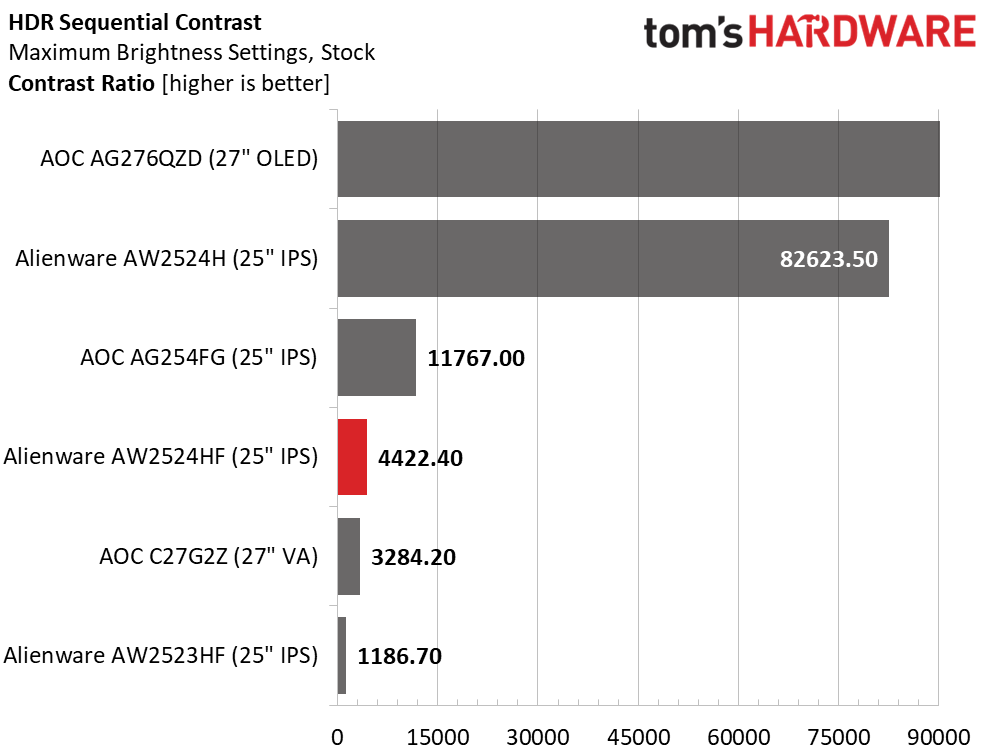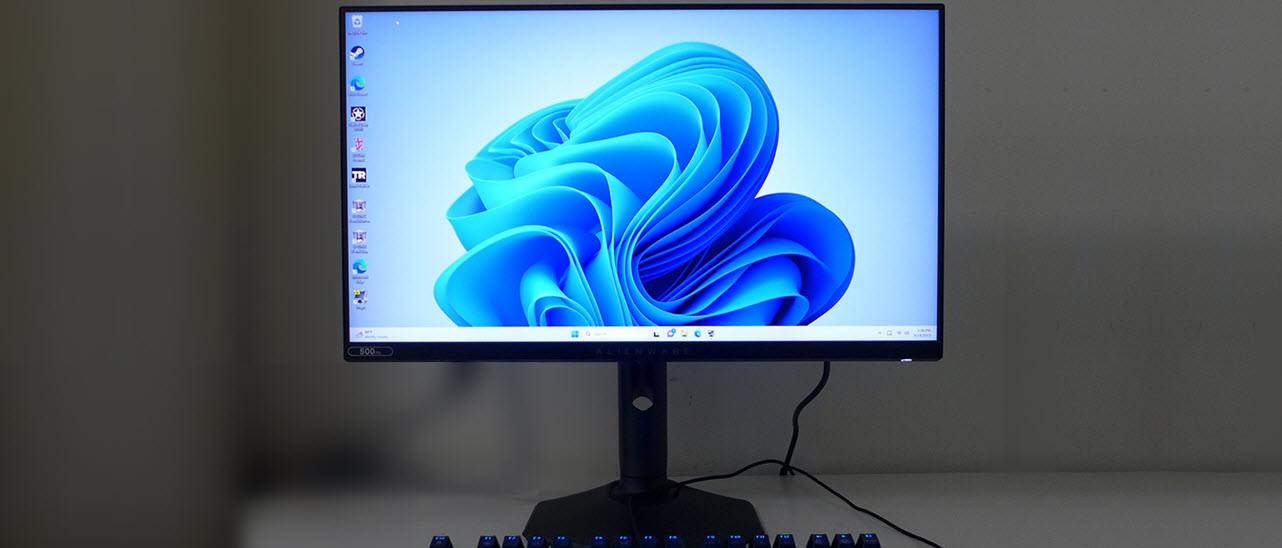Why you can trust Tom's Hardware
Our HDR benchmarking uses Portrait Displays’ Calman software. To learn about our HDR testing, see our breakdown of how we test PC monitors.
The AW2524HF supports HDR10 signals with an automatic switchover once you’ve engaged one of the four modes for the first time. I used Display for all tests and gameplay. It’s the most accurate and best-looking choice. I noted that unlike most HDR monitors, Alienware has included a Custom HDR mode with adjustable color and contrast, a nice touch.
HDR Brightness and Contrast



HDR quality isn’t a huge selling point for exotically fast monitors. The AW2524HF supports HDR seamlessly and even adds contrast with a field-dimming feature. But it won’t deliver life-changing HDR like a Mini LED or OLED panel. It beats out the AW2523HF and C27G2Z, which don’t have dynamic contrast. Interestingly, the AW2524H has a far more aggressive dimming feature, making its HDR contrast much higher. The AG276QZD has infinite dynamic range, as all OLEDs do. The bottom line is that the AW2524HF does a decent job, but there is better HDR contrast available from slower monitors.
Grayscale, EOTF and Color



The AW2524HF’s HDR Display mode has extremely accurate grayscale and EOTF tracking. There are no visible errors at any brightness step, and the luminance transitions to tone mapping at just over 60%, which is correct for the measured peak white level.
You can see a bit of over-saturation in the gamut tests, which is fine since it tracks linearly. There isn’t enough color at the green and cyan end of the triangle, but there is plenty of red and blue. HDR content looks more colorful than SDR. Hue points are on target as well. The Rec.2020 chart shows the same behavior, meaning all HDR content, regardless of the color standard it’s mastered, will look better than its SDR counterpart. This is excellent performance.
Test Takeaway: Of the three Alienware monitors profiled here, the AW2524HF has the best HDR color, while the AW2524H has the best HDR contrast. Since speed is the main thing buyers are expecting, this small difference in HDR quality isn’t a concern. If you want the ultimate in HDR imagery, buy an OLED or Mini LED panel and accept its slower performance.
MORE: Best Gaming Monitors
Get Tom's Hardware's best news and in-depth reviews, straight to your inbox.
MORE: How We Test PC Monitors
MORE: How to Buy a PC Monitor
MORE: How to Choose the Best HDR Monitor

Christian Eberle is a Contributing Editor for Tom's Hardware US. He's a veteran reviewer of A/V equipment, specializing in monitors. Christian began his obsession with tech when he built his first PC in 1991, a 286 running DOS 3.0 at a blazing 12MHz. In 2006, he undertook training from the Imaging Science Foundation in video calibration and testing and thus started a passion for precise imaging that persists to this day. He is also a professional musician with a degree from the New England Conservatory as a classical bassoonist which he used to good effect as a performer with the West Point Army Band from 1987 to 2013. He enjoys watching movies and listening to high-end audio in his custom-built home theater and can be seen riding trails near his home on a race-ready ICE VTX recumbent trike. Christian enjoys the endless summer in Florida where he lives with his wife and Chihuahua and plays with orchestras around the state.
-
Sluggotg When the early First Person Shooters showed up, (Doom, Rise of the Triad, Descent etc.), 10 FPS was considered playable. 24 FPS was thought to be perfect because that is the Frame Rate of Film. Then the hardware caught up and we saw what 60 FPS looked like. That was a "Game Changer", (Pun intended).Reply
I love a high frame rates. 144 FPS is great. Do I need 500 FPS, not likely, but I do want to try it. My only complaint is the size. I wish it was bigger. -
Kamen Rider Blade My main issue is that it's using IPS for 500 Hz VRR.Reply
IPS doesn't have the pixel reaction time to support 500 Hz w/o ghosting.
It's not like OLED or classic CRT.
Yes, you can OC the panel to support it, but there will be issues with it. -
Sleepy_Hollowed Reply
I don't know about 500 Hz, but it works pretty good up to 160 Hz, no ghosting.Kamen Rider Blade said:My main issue is that it's using IPS for 500 Hz VRR.
IPS doesn't have the pixel reaction time to support 500 Hz w/o ghosting.
It's not like OLED or classic CRT.
Yes, you can OC the panel to support it, but there will be issues with it.
I'd imagine that's imperceptible at those refresh rates, but I'd have to see it in person. -
UnforcedERROR ReplySluggotg said:My only complaint is the size. I wish it was bigger.
Whose Line is it Anyway moment: Comments your girlfriend might say about you or your TV.
Joking aside, 25" at 1080p is about all you'd ever want, really. Unless you're gaming at a considerable difference, I'd never personally recommend a monitor larger than 25" if it's 1080p, because the pixel density is pretty low up close. I mean, the 500hz is because it's at 1080p, and this is mostly for diehard FPS players, but I'd still prefer lower refresh for higher pixel density.
